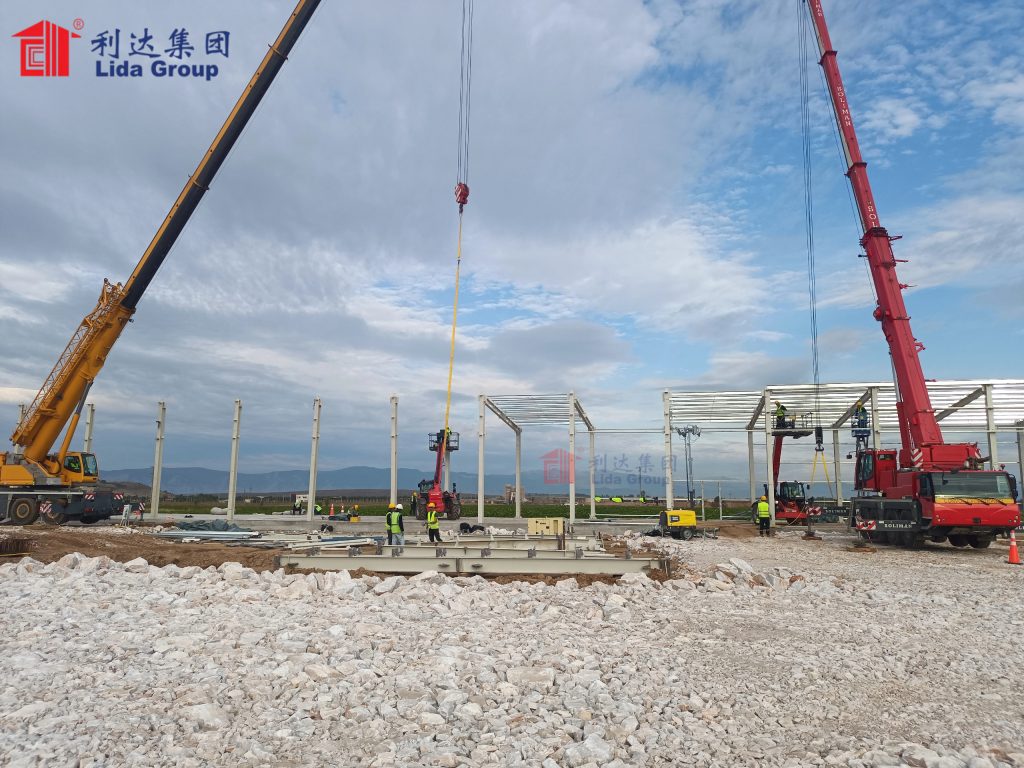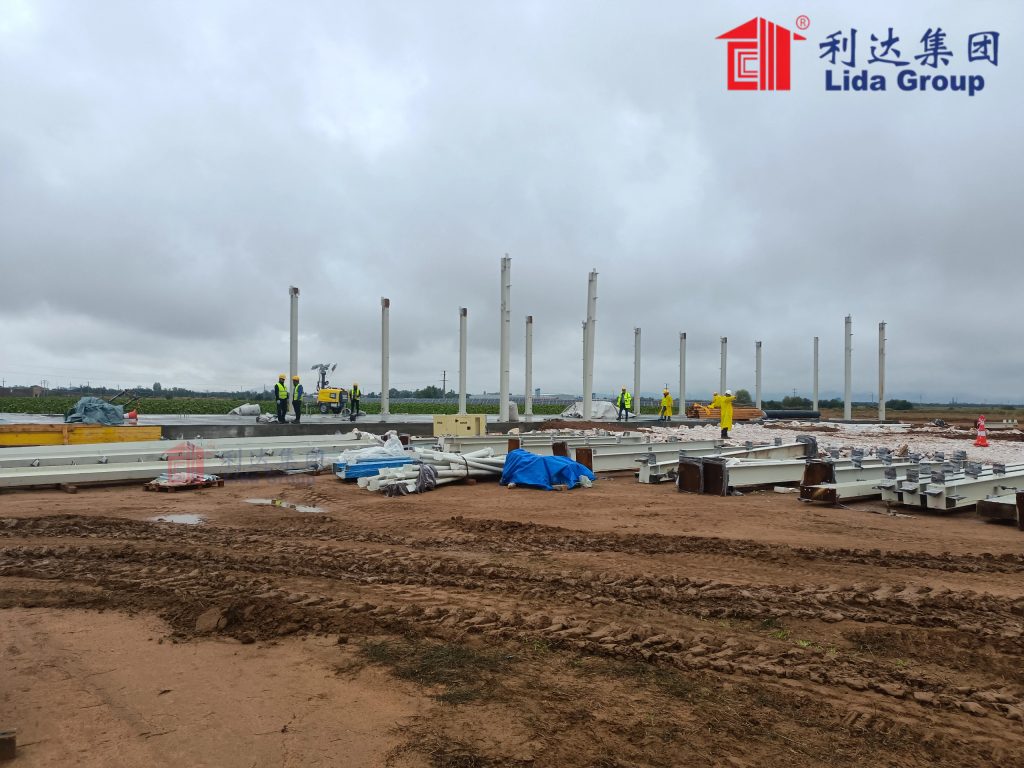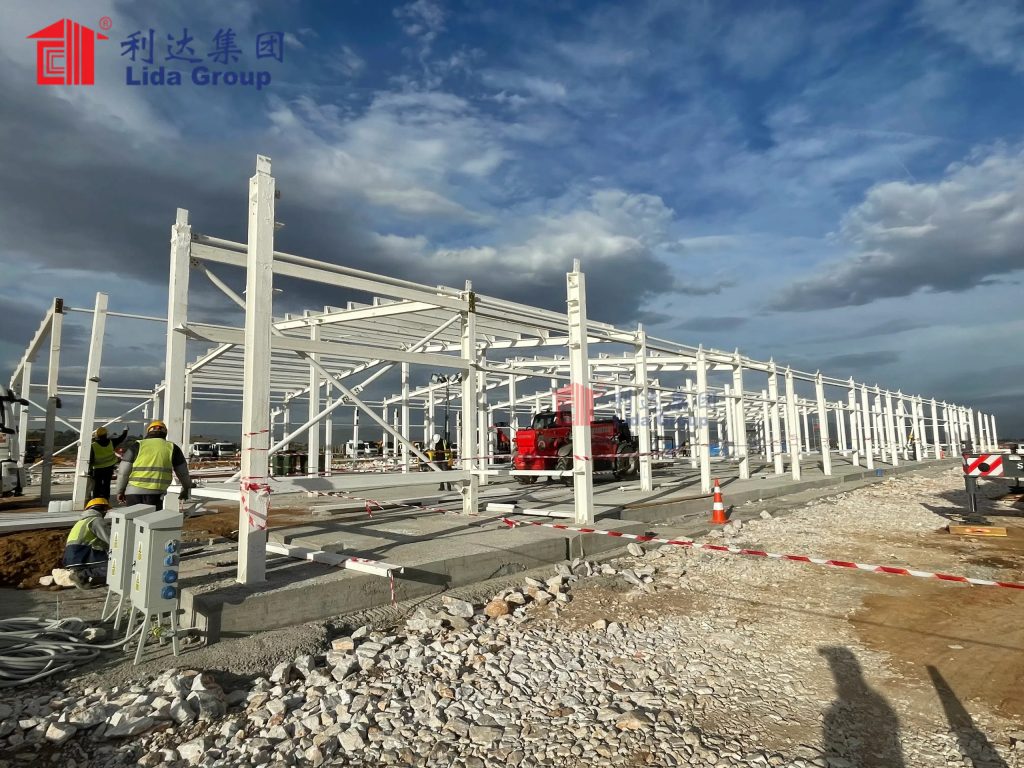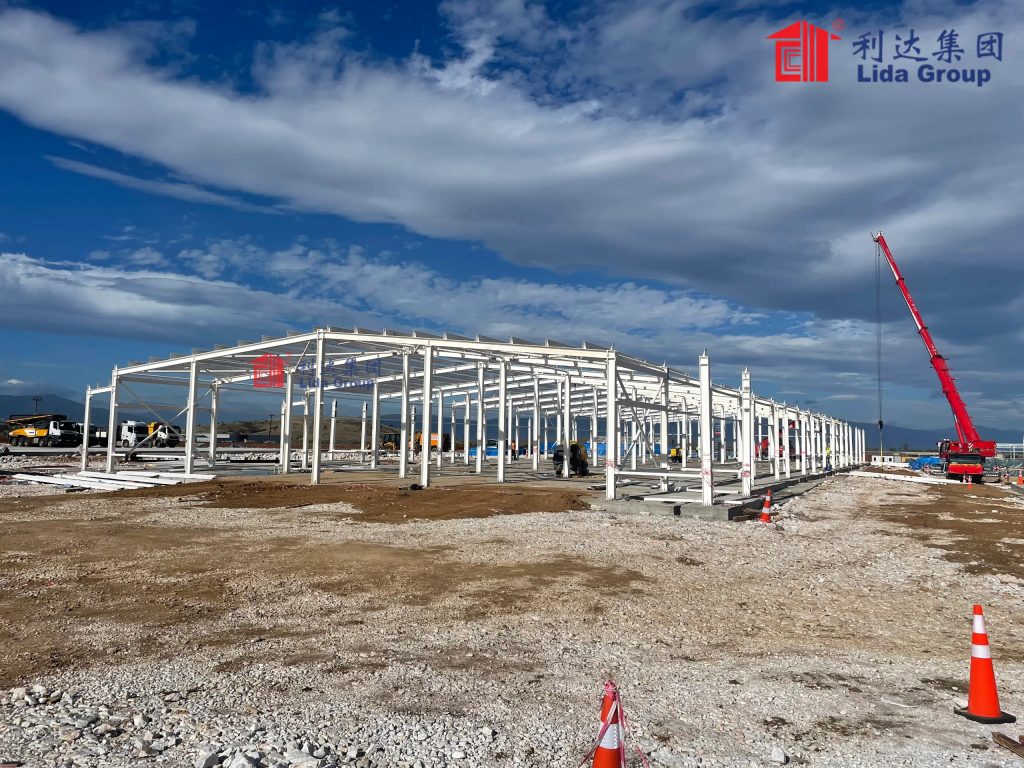Transforming Poultry and Livestock Management with Lida Group’s Ventilated and Hygienic Steel Frame Building Solutions
2025-Sep-15 14:54:21
By Admin
1. Introduction
Poultry and livestock farming are critical pillars of global food security, supplying billions with protein-rich products like eggs, meat, and dairy. Yet, the industry faces mounting challenges that threaten productivity, animal welfare, and profitability. Traditional livestock housing—often constructed from wood, low-grade concrete, or makeshift materials—fails to address two of the most pressing issues: poor ventilation and inadequate hygiene. These flaws lead to a cascade of problems: respiratory diseases in poultry, ammonia buildup in dairy barns, high mortality rates, and non-compliance with increasingly strict animal welfare regulations.
For farmers, the costs of these inefficiencies are staggering. A poultry farm with poor ventilation may lose 10–15% of its flock to respiratory illnesses annually, translating to \(50,000–\)100,000 in lost revenue for a mid-sized operation. A dairy farm with unsanitary housing faces higher somatic cell counts in milk (leading to price penalties from processors) and increased vet bills for treating udder infections. Meanwhile, consumers and regulators are demanding higher standards: 78% of global consumers now prioritize “humanely raised” labels, and governments worldwide (e.g., the EU’s Council Directive 98/58/EC, the U.S. Animal Welfare Act) have tightened rules on livestock housing conditions.
Lida Group, a global leader in steel frame construction, has developed a transformative solution for poultry and livestock management: ventilated and hygienic steel frame building solutions. Unlike traditional housing, these structures are engineered from high-quality steel to prioritize optimal air flow, easy sanitation, and animal comfort. By integrating specialized ventilation systems, non-porous surfaces, and modular designs, Lida Group’s buildings reduce disease risk, lower operational costs, and ensure compliance with modern welfare standards. For farmers, this means healthier flocks/herds, higher product quality, and a more sustainable business model.
This article explores how Lida Group’s ventilated and hygienic steel frame buildings are revolutionizing poultry and livestock management. It begins by examining the core challenges of traditional livestock housing, then delves into the technical innovations that define Lida Group’s solutions—from precision ventilation systems to hygienic design features. The article also highlights measurable benefits for farmers, supported by real-world case studies from diverse regions. Finally, it concludes with a vision of how these buildings are shaping the future of sustainable, ethical livestock farming.

2. The Crisis in Traditional Livestock Housing: Ventilation and Hygiene Failures
To fully appreciate the impact of Lida Group’s solutions, it is essential to first understand the systemic flaws of traditional poultry and livestock housing—and how these flaws undermine every aspect of farm operations.
2.1 Poor Ventilation: A Silent Threat to Animal Health and Productivity
Ventilation is critical for livestock: it removes toxic gases (ammonia, carbon dioxide), controls temperature and humidity, and reduces pathogen levels in the air. Traditional housing fails to deliver adequate ventilation, leading to severe consequences:
2.1.1 Toxic Gas Buildup
Manure decomposition releases ammonia—a highly irritating gas that damages respiratory tissues in poultry and livestock. In traditional wooden or concrete barns with fixed windows or inadequate fans:
- Poultry Farms: Ammonia levels often exceed 50 ppm (parts per million)—well above the 25 ppm threshold recommended by the World Organization for Animal Health (WOAH). This causes chronic respiratory stress in chickens, reducing egg production by 10–15% and increasing mortality rates by 8–12%.
- Dairy Farms: Ammonia levels of 40+ ppm irritate cows’ eyes and nasal passages, leading to reduced feed intake (by 5–7%) and lower milk production (by 3–5%). A 2023 study by the American Dairy Science Association found that dairy farms with poor ventilation lost an average of $1,200 per cow annually due to reduced productivity.
2.1.2 Temperature and Humidity Extremes
Traditional housing lacks precise climate control, making it vulnerable to temperature swings:
- Heat Stress: In summer, unventilated barns can reach temperatures of 35–40°C, causing heat stress in poultry (reducing eggshell quality and hatch rates) and dairy cows (lowering milk yield by 15–20%). A poultry farm in Georgia reported losing 2,000 chickens to heat stress in a single summer, costing $12,000.
- Cold Stress: In winter, drafty wooden barns fail to retain heat, leading to cold stress in newborn calves (mortality rates of 15–20%) and poultry (increased feed consumption by 10% to maintain body temperature).
2.1.3 Poor Air Circulation and Pathogen Spread
Stagnant air in traditional housing allows pathogens (bacteria, viruses, mold spores) to accumulate, increasing disease risk:
- Poultry: Avian influenza and Newcastle disease spread rapidly in poorly ventilated flocks. A 2022 outbreak in a U.S. poultry farm with traditional housing cost $2 million in flock culling and biosecurity measures.
- Swine: Porcine reproductive and respiratory syndrome (PRRS) is 30% more likely to spread in barns with inadequate air flow, leading to \(200–\)300 in losses per infected pig.
2.2 Hygiene Failures: The Hidden Cost of Hard-to-Clean Surfaces
Traditional livestock housing materials—wood, porous concrete, and fabric—are difficult to clean and disinfect, creating breeding grounds for bacteria, parasites, and mold:
2.2.1 Porous and Absorbent Materials
- Wooden Barns: Wood absorbs manure, urine, and cleaning chemicals, making it impossible to fully sanitize. Bacteria like Salmonella and E. coli persist in wood fibers, leading to recurrent infections in flocks/herds. A poultry farm in Brazil reported 4 salmonella outbreaks in 2 years due to contaminated wooden nesting boxes.
- Porous Concrete: Unsealed concrete floors absorb moisture and organic matter, harboring pathogens like Clostridium perfringens (a leading cause of necrotic enteritis in poultry). Cleaning these floors requires excessive water and chemicals, increasing operational costs by \(3,000–\)5,000 annually for a mid-sized farm.
2.2.2 Hard-to-Reach Spaces
Traditional housing designs include tight corners, crevices, and overhead beams that trap manure and debris. These areas are impossible to clean with standard equipment, leading to:
- Mold Growth: Mold in poultry barns produces mycotoxins that contaminate feed, reducing egg production and causing liver damage in chickens.
- Parasite Infestations: Dark, dirty corners attract mites, lice, and rodents—costing farmers \(2,000–\)4,000 annually in pest control and vet bills.
2.2.3 Regulatory Non-Compliance
Modern animal welfare regulations require strict hygiene standards, and traditional housing often fails to meet these requirements:
- The EU’s “General Food Law” mandates that livestock housing be “easy to clean and disinfect” to prevent foodborne illness. Farms with traditional housing face fines of up to €50,000 for non-compliance.
- In the U.S., the Food Safety and Inspection Service (FSIS) conducts regular hygiene audits; farms with poor housing scores face restrictions on selling products to major retailers.

3. Lida Group’s Steel Frame Solutions: Ventilation and Hygiene by Design
Lida Group’s ventilated and hygienic steel frame buildings address the failures of traditional housing through three core innovations: precision ventilation systems, hygienic material selection, and modular, easy-to-clean design. These features are engineered into every component of the building—from the steel frame to the flooring and wall panels—ensuring optimal conditions for poultry and livestock.
3.1 Precision Ventilation Systems: Tailored for Livestock Needs
Lida Group’s buildings are equipped with animal-specific ventilation systems that maintain optimal air quality, temperature, and humidity—regardless of external weather conditions. These systems are designed to adapt to the unique needs of different species (poultry, dairy, swine) and production stages (chicks, calves, adult animals).
3.1.1 Variable-Speed Fan Arrays
At the heart of the ventilation system are variable-speed axial fans (mounted in walls or roofs) that adjust airflow based on real-time sensor data. Key features include:
- Species-Specific Sizing: Poultry barns use smaller, high-density fans (1.2–1.5 meters in diameter) to deliver 0.5–1.0 m³ of air per bird per minute—preventing ammonia buildup. Dairy barns use larger fans (2.0–2.5 meters in diameter) to move 3–5 m³ of air per cow per minute, reducing heat stress.
- Smart Speed Control: Fans connect to a central control panel (CCP) with temperature, humidity, and ammonia sensors. If ammonia levels rise above 25 ppm (poultry) or 30 ppm (dairy), the CCP increases fan speed to remove toxic gases. For example, a poultry barn in Texas automatically increases fan speed from 50% to 100% when temperatures exceed 28°C, keeping birds cool without wasting energy.
- Energy Efficiency: Variable-speed fans use 30–40% less energy than fixed-speed fans, reducing electricity costs by \(2,000–\)4,000 annually for a 1,000-square-meter barn.
3.1.2 Inlet and Air Distribution Systems
To ensure uniform airflow (critical for preventing “dead zones” where gases accumulate), Lida Group’s buildings include:
- Adjustable Inlets: Wall-mounted inlets (with motorized dampers) regulate the amount and direction of fresh air entering the barn. In winter, inlets direct warm air toward the floor (keeping chicks or calves warm); in summer, they draw in cool air from above.
- Air Diffusers: For poultry barns, ceiling-mounted air diffusers distribute fresh air evenly across the flock—preventing drafts that stress young birds. For swine barns, under-floor air inlets deliver fresh air directly to pig pens, reducing pathogen exposure.
- Heat Recovery Ventilators (HRVs): In cold climates, HRVs capture heat from exhaust air and transfer it to incoming fresh air—reducing heating costs by 25–30%. A dairy barn in Canada uses HRVs to maintain 18–22°C in winter, cutting propane costs by $3,500 annually.
3.1.3 Evaporative Cooling for Heat-Prone Regions
In hot, dry climates (e.g., the U.S. Southwest, Australia), Lida Group adds evaporative cooling pads to the ventilation system:
- Pad Placement: Pads are installed on the intake side of the barn, and fans pull air through the wet pads—lowering incoming air temperature by 8–12°C.
- Automatic Water Control: The CCP regulates water flow to the pads based on temperature and humidity, ensuring optimal cooling without wasting water. A poultry farm in Arizona reported that evaporative cooling reduced summer mortality rates from 12% to 3%, saving $45,000 annually.
3.2 Hygienic Material Selection: Non-Porous, Easy-to-Sanitize Surfaces
Lida Group prioritizes non-porous, corrosion-resistant materials that eliminate pathogen hiding spots and simplify cleaning. Every surface—from walls and floors to nesting boxes and feeding troughs—is designed to be washed, disinfected, and dried quickly.
3.2.1 Galvanized Steel Wall and Roof Panels
The building’s exterior and interior walls are made of hot-dip galvanized steel panels (0.8–1.2 mm thick) with a smooth, non-porous finish. Key benefits include:
- No Absorption: Steel does not absorb manure, urine, or chemicals—unlike wood or porous concrete. A quick wash with high-pressure water (3,000 psi) removes all organic matter, and disinfectants (e.g., quaternary ammonium compounds) penetrate evenly to kill pathogens.
- Corrosion Resistance: Hot-dip galvanization protects steel from rust and chemical damage (from cleaning agents or manure acids), ensuring the panels remain hygienic for 20–30 years.
- Mold Prevention: The smooth surface prevents mold growth, even in humid environments. A swine barn in Thailand (90% annual humidity) has operated for 5 years with zero mold-related issues, compared to quarterly mold outbreaks in its previous wooden barn.
3.2.2 Sealed Concrete Floors with Drainage
Floors are made of high-strength concrete (200–250 mm thick) with two critical hygienic features:
- Sealed Surface: Concrete is treated with a food-safe epoxy sealant that creates a non-porous barrier—preventing bacteria from seeping into the material. This reduces the risk of E. coli and Salmonella contamination by 70–80%.
- Sloped Drainage: Floors slope at 1–2% toward floor drains (spaced every 3–4 meters), ensuring manure and cleaning water drain quickly. This eliminates standing water (a breeding ground for pathogens) and reduces cleaning time by 50% compared to traditional barns. A dairy farm in Wisconsin reported cutting daily cleaning time from 4 hours to 2 hours, saving $12,000 annually in labor costs.
3.2.3 Hygienic Interior Fixtures
Lida Group’s buildings include sanitizable interior fixtures designed for easy cleaning:
- Poultry Nesting Boxes: Made of food-grade plastic (or galvanized steel) with no crevices—nest boxes can be removed, pressure-washed, and disinfected in minutes. This reduces egg contamination by 30–40% compared to wooden nesting boxes.
- Dairy Feeding Troughs: Stainless steel troughs with smooth edges and removable dividers—they can be cleaned with a single pass of a pressure washer, eliminating feed residue that attracts pests.
- Swine Pen Dividers: Galvanized steel dividers with rounded corners—no sharp edges or gaps to trap manure. A swine farm in Brazil reported a 50% reduction in parasite infestations after switching to these dividers.
3.3 Modular, Easy-to-Clean Design: Minimizing Hidden Contamination Zones
Traditional housing’s biggest hygiene flaw is hard-to-reach spaces (corners, crevices, overhead beams) that trap debris. Lida Group’s modular steel frame design eliminates these zones, making every surface accessible for cleaning.
3.3.1 Open, Clear-Span Layouts
Lida Group’s buildings use clear-span steel frames (15–30 meters wide) with no internal columns. This creates:
- Unobstructed Access: Cleaners can move large equipment (e.g., floor scrubbers, pressure washers) freely across the barn, reaching every corner without navigating around columns.
- Uniform Cleaning: No hidden spaces mean no missed spots—reducing pathogen buildup by 60–70%. A poultry farm in Indiana reported that its clear-span Lida Group barn required 30% fewer disinfection treatments annually than its column-filled traditional barn.
3.3.2 Modular Pen and Partition Systems
For farms with multiple animals (e.g., dairy herds, swine groups), Lida Group uses modular pen systems with:
- Removable Partitions: Steel partitions can be easily detached and moved, allowing deep cleaning of pen floors and walls. This is critical for “all-in/all-out” production systems (common in poultry farming), where barns are fully emptied and sanitized between flocks.
- Adjustable Sizing: Partitions can be repositioned to change pen size—accommodating growing animals (e.g., from chicks to adult hens) without rebuilding. A poultry farm in Mexico adjusts pen sizes every 2 weeks, reducing stress on birds and improving growth rates by 8%.
3.3.3 Overhead Utility Routing
Electrical wires, water pipes, and ventilation ducts are routed through ceiling-mounted utility channels (instead of being hidden in walls or floors). This:
- Eliminates Hidden Contamination: No pipes or wires run along the floor or in wall cavities—areas that trap manure and are impossible to clean.
- Simplifies Maintenance: Utilities are easily accessible for inspection and cleaning, reducing the risk of water leaks (which cause mold) or electrical malfunctions (which require unsanitary repairs).

4. Measurable Benefits: Transforming Livestock Operations
Lida Group’s ventilated and hygienic steel frame buildings deliver tangible benefits for farmers—from improved animal health to lower costs and regulatory compliance. These benefits are not just theoretical; they are validated by data from real-world operations.
4.1 Improved Animal Health and Productivity
The most significant benefit of Lida Group’s buildings is healthier, more productive livestock:
- Poultry Farms:
-
- Mortality rates drop by 8–15% (from 12–20% in traditional barns to 5–7% in Lida Group buildings) due to better ventilation and hygiene.
-
- Egg production increases by 10–12% (from 280–300 eggs per hen per year to 310–335) because of reduced stress and disease.
-
- Hatch rates rise by 5–8% (from 80–85% to 85–88%) due to optimal temperature and humidity control.
-
- Dairy Farms:
-
- Milk production increases by 3–5% (from 7,000–7,500 liters per cow per year to 7,200–7,800) due to reduced heat stress and improved air quality.
-
- Somatic cell counts (a marker of udder health) drop by 20–30% (from 300,000–400,000 cells/mL to 210,000–280,000), qualifying milk for premium pricing from processors.
-
- Calf mortality rates decrease by 10–15% (from 15–20% to 5–10%) thanks to controlled temperature and humidity in calf housing areas.
- Swine Farms:
-
- Average daily gain (ADG) for finishing pigs increases by 5–7% (from 0.8–0.9 kg/day to 0.84–0.96 kg/day) due to better feed conversion and reduced disease.
-
- Piglet mortality rates fall by 8–12% (from 12–15% to 4–7%) because of improved hygiene and reduced pathogen exposure.
-
- PRRS outbreak frequency drops by 50–60%, saving \(10,000–\)20,000 per outbreak in vet bills and lost production.
4.2 Significant Cost Reductions
Lida Group’s buildings lower operational costs across all areas of livestock management:- Labor Savings: Reduced cleaning time (by 50%) and fewer disease-related tasks (e.g., treating sick animals) cut labor costs by \(15,000–\)30,000 annually for a mid-sized farm. A poultry farm in Arkansas reported eliminating one full-time cleaning position ($35,000/year salary) after switching to a Lida Group barn.
- Veterinary and Medication Savings: Healthier livestock require fewer vet visits and less medication. A dairy farm in New Zealand reduced vet costs by $8,000/year and antibiotic use by 40%—also qualifying for “low-antibiotic” premium labels.
- Energy Savings: Variable-speed fans, HRVs, and efficient insulation reduce electricity and heating costs by \(3,000–\)6,000 annually. A swine farm in Canada cut propane use by 35% in winter, saving $4,200/year.
- Feed Savings: Reduced stress and optimal climate control improve feed conversion ratios (FCR). Poultry farms see FCR improve by 5–8% (from 2.0–2.2 to 1.9–2.05), saving \(20,000–\)30,000 annually on feed costs for a 100,000-bird flock.
4.3 Regulatory Compliance and Market Access
Lida Group’s buildings ensure compliance with global animal welfare and food safety regulations, opening access to premium markets:- Welfare Certification: The buildings meet standards for “humanely raised” labels (e.g., Global Animal Partnership, EU Organic), which command 15–30% higher prices. A poultry farm in the UK now sells eggs to high-end retailers for £1.20/dozen (vs. £0.90/dozen for conventional eggs), increasing annual revenue by $60,000.
- Food Safety Compliance: Non-porous surfaces and easy sanitization help farms pass FSIS, EU, and local hygiene audits. A swine farm in Brazil, which previously failed two audits due to unsanitary traditional housing, has passed all audits since installing Lida Group buildings—allowing exports to the EU.
- Reduced Fines and Penalties: Compliance eliminates the risk of regulatory fines (up to €50,000 in the EU) and product recalls. A U.S. dairy farm avoided a $25,000 FSIS fine after switching to a Lida Group barn, as its previous concrete facility failed to meet hygiene standards.

5. Real-World Case Studies: Transforming Livestock Operations Globally
To validate the impact of Lida Group’s ventilated and hygienic steel frame buildings, below are three detailed case studies from diverse livestock sectors and regions. Each case highlights the unique challenges faced, the customized Lida Group solution, and the measurable outcomes achieved.5.1 Case Study 1: Commercial Poultry Farm in Georgia, USA
Challenges: The farm raised 200,000 broiler chickens annually in 4 traditional wooden barns. Key issues included:- High summer mortality (12%) due to heat stress.
- Frequent salmonella outbreaks (2–3 per year) from unsanitary wooden surfaces.
- Labor-intensive cleaning (4 hours/day per barn) and high feed costs.
Lida Group’s Solution: Two 1,800-square-meter steel frame broiler barns with:- Variable-speed fan arrays (24 fans per barn) and evaporative cooling pads for summer.
- Hot-dip galvanized steel walls, sealed concrete floors, and plastic nesting boxes.
- Clear-span design (24-meter width) for unobstructed cleaning and air flow.
- Central control panel with temperature, humidity, and ammonia sensors.
Results:- Mortality Reduction: Summer mortality dropped from 12% to 3%, saving 18,000 chickens annually ($108,000 in revenue).
- Disease Elimination: No salmonella outbreaks in 2 years, eliminating $15,000/year in vet bills and product losses.
- Cost Savings: Labor costs cut by \(28,000/year (one fewer cleaning worker), feed costs reduced by \)24,000/year (5% better FCR), and energy costs down by $3,500/year.
- Market Access: Qualified for “humanely raised” certification, selling chickens to a national restaurant chain for 20% higher prices—adding $48,000/year in revenue.
5.2 Case Study 2: Dairy Farm in New Zealand
Challenges: The farm milked 350 cows in 2 concrete barns built in the 1980s. Challenges included:- Low milk production (7,000 liters/cow/year) due to poor ventilation and ammonia buildup (45 ppm).
- High calf mortality (18%) from cold, drafty calf pens.
- Failed organic certification audits due to unsanitary concrete floors (mold and bacteria buildup).
Lida Group’s Solution: A 2,500-square-meter steel frame dairy barn with:- Large variable-speed fans (10 fans, 2.2-meter diameter) and HRVs for winter heating.
- Sealed epoxy floors with sloped drainage and stainless steel feeding troughs.
- Dedicated calf housing module with temperature control (18–20°C) and non-porous surfaces.
- Air quality sensors linked to the CCP (triggering fan adjustments at 30 ppm ammonia).
Results:- Milk Production Increase: Milk yield rose to 7,500 liters/cow/year (+7%), generating $35,000/year in additional revenue.
- Calf Mortality Drop: Calf mortality fell to 6%, saving 33 calves annually ($19,800 in revenue).
- Certification Success: Achieved organic certification, selling milk for \(0.20/liter more (\)70,000/year in extra revenue).
- Cost Savings: Vet bills reduced by \(8,000/year, heating costs cut by \)4,200/year (35% propane savings), and cleaning time halved (saving $12,000/year in labor).
5.3 Case Study 3: Swine Farm in Thailand
Challenges: The farm raised 1,200 finishing pigs annually in 3 wooden barns. Key issues included:- High humidity (90% year-round) causing mold growth and PRRS outbreaks (1–2 per year).
- Slow pig growth (ADG: 0.8 kg/day) due to heat stress (barn temperatures up to 38°C in summer).
- Inability to export to Singapore (a key market) due to poor hygiene scores.
Lida Group’s Solution: Three 1,200-square-meter steel frame swine barns with:- Evaporative cooling systems and high-density variable-speed fans (15 fans per barn) for heat control.
- Hot-dip galvanized steel walls (resistant to humidity) and sealed concrete floors.
- Modular pen dividers (removable for deep cleaning) and overhead utility channels.
- Mold-resistant insulation and humidity sensors linked to the CCP.
Results:- Growth Improvement: ADG increased to 0.95 kg/day (+19%), reducing time to market by 10 days—saving $15,000/year in feed costs.
- Disease Prevention: No PRRS outbreaks in 3 years, saving $15,000/year in vet bills and lost production.
- Export Access: Achieved Singapore’s hygiene standards, exporting 40% of pigs for 30% higher prices—adding $60,000/year in revenue.
- Hygiene Improvement: Mold growth eliminated, reducing cleaning chemical use by 50% ($3,000/year savings) and improving worker health (no more respiratory issues from mold).
6. Conclusion
In conclusion, Lida Group’s ventilated and hygienic steel frame building solutions represent a paradigm shift in poultry and livestock management—addressing the longstanding failures of traditional housing to prioritize animal health, operational efficiency, and regulatory compliance. By integrating precision ventilation systems, non-porous hygienic materials, and modular designs, these buildings transform livestock operations from reactive, cost-intensive systems to proactive, sustainable ones.The measurable benefits are undeniable: healthier livestock with lower mortality rates (down by 8–15%), increased productivity (milk yield up by 3–5%, egg production up by 10–12%), and significant cost reductions (labor, vet, energy, and feed costs cut by \(15,000–\)60,000 annually). Beyond financial gains, these buildings unlock access to premium markets through “humanely raised” and organic certifications, while eliminating the risk of regulatory fines and product recalls.Real-world case studies—from a U.S. poultry farm reducing mortality by 75% to a New Zealand dairy farm achieving organic certification—validate that Lida Group’s solutions are not just theoretical but proven to deliver results across diverse climates and livestock sectors. These buildings are not just “better barns”; they are strategic tools that empower farmers to meet the dual demands of modern agriculture: producing more food with fewer resources, while upholding ethical animal welfare and food safety standards.As the global livestock industry faces growing pressure to become more sustainable and ethical, Lida Group’s ventilated and hygienic steel frame buildings are poised to become the new standard. They demonstrate that profitability and sustainability are not mutually exclusive—and that investing in high-quality, animal-centric infrastructure is the key to long-term success. For farmers seeking to future-proof their operations, Lida Group’s solutions offer a clear path forward: one where livestock thrive, costs decrease, and businesses grow—all while contributing to a more responsible food system.In essence, Lida Group has redefined what livestock housing can be: no longer a passive structure, but an active partner in creating healthier, more efficient, and more sustainable poultry and livestock operations. This is the future of livestock management—and it starts with better buildings.

Related news
-
Cost-Effective Expansion for Agribusiness: Lida Group's Pre-Engineered Steel Farm Houses Reduce Construction Time and Budget
2025-09-15 14:26:24
-
Lida Group Sets a New Industry Standard for Modern Farming with Its High-Quality Steel Structure Warehouses
2025-09-15 14:34:52
-
The Future of Farming Infrastructure: Smart Technology Integration in Lida Group's High-Quality Steel Farm Houses
2025-09-15 14:48:27
contact us
- Tel: +86-532-88966982
- Whatsapp: +86-13793209022
- E-mail: sales@lidajituan.com


